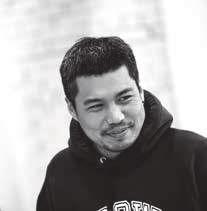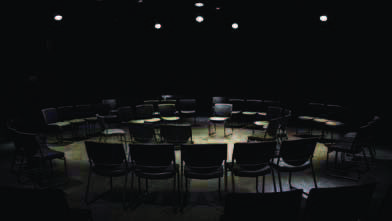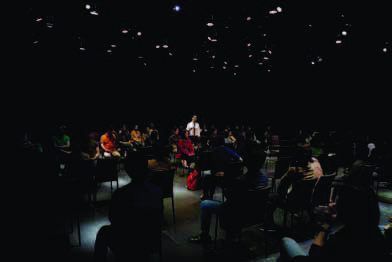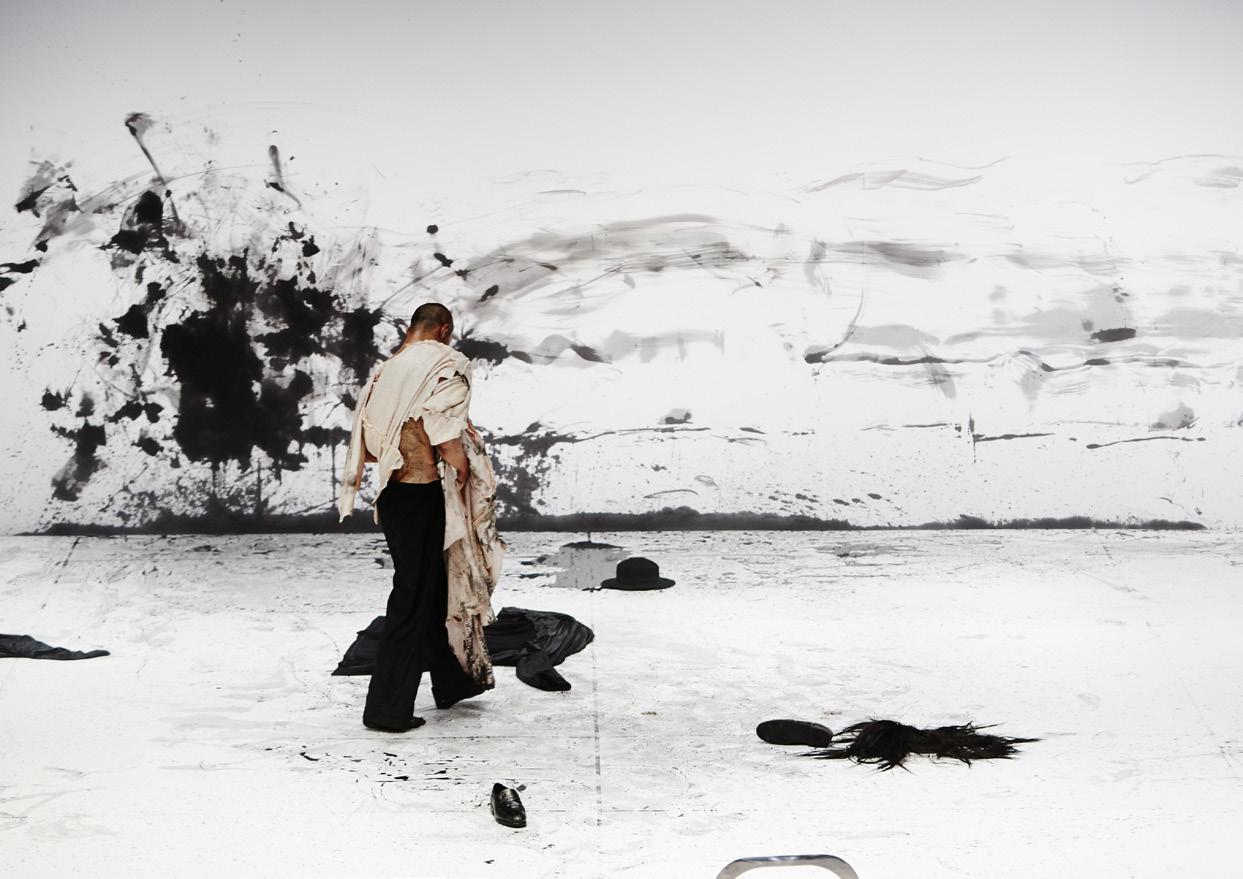Performance Info
PARK Hae Sung (Theatre director. Director of the theatre company IMAGINEATRE.)
: To exist in the theatre, looking at the phenomenon
I heard you were not much interested in art until you went to university where you got involved in theatre. What led you to theatre?
I came to learn about theatre at university. I didn’t know anything about theatre before. My major was computer science but I was more fascinated by the plays I did as a member of a theatre club. There were times that there were more plays that I made than those I watched in fact. Right before the graduation, I made an adaptation of Samuel Beckett’s Waiting for Godot, but I could understand the key structure of the work after it was presented on stage. I was frustrated as I thought I didn’t produce a high quality work. Just then, I was admitted to the School of Drama of Korea National University of Arts. However, I was kind of lost there rather than well adjusted. Due to my stubborn nature, I didn’t get along well with my professors. With a lack of a profound insight or faith in theatre, I didn’t even think of becoming a professional theatre director.
While considering joining the military or studying abroad for 4-5 years, I had an opportunity to work as an assistant director under the director LEE Soo Yin, which led me to make plans for the future as a theatrical artist.
During the last 10 years, you have worked in a wide range of fields, including interpretation of classics, Origin of Belief series, work with playwrights as well as works commissioned by producing theatres. Please tell us about your activities so far.
Back in university, I staged the productions of Copenhagen (by Michael Frayn, 2007) and Phèdre (by Racine). From that moment on, I started to have my own view of theatre. After graduation, I showcased 1/12 (based on Osamu Dazai’s novel, 2009) at the Seoul Fringe Festival and Titus (2009), based on Shakespeare play, at the CJ Young Festival with Yangson Project.(Titus was performed again at SPAF in 2011). Then I presented Seven Jewish Children : a play for Gaza (2010) based on the Caryl Churchill’s play 『Seven Jewish Children』 at Theatre Olympics in Seoul. Eternal Thee (2012) and A Thousand of Eyes (2013) were created in collaboration with the playwright CHUNG Young Hoon in 2012 and 2013 respectively. In 2012, I collaborated with the Australian theatre troupe One Step at a Time Like This on the project En Route that invites the public on a journey throughout the city away from the theatre for the SPAF.
You chose the Origin of Belief series as your signature work. Origin of Belief 2 was also selected as the Best 3 Korean Plays in 2015.
Origin of Belief is a project that has been developed by Doosan Art Lab since 2011. The project raises the question of ’belief’ with a theme of family. Origin of Belief 2: Winds of Fukushima (2016) dealing with the Fukushima nuclear accident discusses about the faith in science. It is intended to question and explore the origin of belief that ’Science is beneficial to humans.’ Each series has its own criteria for selecting a theme; it should be something that people don’t have any doubt about. The themes of family and science will be followed by ideology and refugees. Religion will probably be the one to be discussed ultimately.
The Origin of Belief series are based on the philosophy of David Hume, an empiricist philosopher. Exploring the inside as well as values of humans, I realized that one has his or her own values and understands the world base on these values. This is the point where my doubt began. Then, is such a ’belief’ ’true’? If we accept the differences of values, co-existing might be possible, instead of being hostile to or killing others because of the belief that we regard as the truth. Meanwhile, I had an impression that it is similar to the state of audiences in the theatre.
Introducing a topic that the audience understand from their own perspective seems to play an important part in your work. Despite a disagreement of opinions, the process of reaching an intermediate agreement itself can be a purpose of the work.
I’m not the kind of person who likes to highlight specific messages for audience, make them laugh or cry. In other words, dramatic communication or exchange of feelings are not of my interest. Rather, I am more interested in investigating the phenomenon, setting the agenda and discussing about it with audiences. Theatre is a good means of calling attention to the dangerous phenomena taking place in today’s world and of making people think about them together. In fact, theatre gave me motivation to take a closer and more careful look at the world.
I find that theatre is a space in which implicit deception takes place. Audiences know but are deceived. However, I focused on another possibility that theatre has. I recognized theatre as a place where audience’s own thoughts co-exist in real time. Suppose an audience in a theatre has his or her own thoughts and these thoughts can be exchanged. Such an imagination led me to think of ‘theatrical thought.’ My goal was to make audiences have experience of thinking through the paly we present to them, and to overcome the limitations of abstract ambiguity, listing of facts or reproduction.
I came to reach this kind of idea from my experience of directing Copenhagen in university. It is a unique play that cannot be staged with reproductive customs on which the existing plays depend. A character, who is a philosopher as well as scientist, leads a debate, rather than a narrative. Reproduction is excluded, and dialogue is mathematical and logical. The process in which audiences reach a scientific thinking in this manner was fascinating. It was also the moment my major computer science, namely ’arithmetic as an application of mathematics’, turned into theatre.
Audiences looked like members participating in a debate over science in Origin of Belief 2 and delegates attending the council meeting in Coriolanus. While the space of theatre and that of audience overlapping, the eyes of the audience are not focused on one spot. The purpose of it is to construct an environment for theatrical thought?
I intended to eliminate artistic decoration and create a stage in the form of a platform with various points of view. The one-way points of performers and those of audiences are to be neutralized. The space of audience and the stage are combined. I paid attention to the ’phenomenon’ that audiences and performers exist in the same space. Performer’s acting becomes ’existing’, not ’showing’, and audiences experience the phenomenon from their own perspective. I made an environment in which audience experience the theatre with their whole bodies by maximizing their identity as performers do. I believe that the most attractive scene in the theatre is to see audiences participating in the process of thinking.
You have directed Shakespeare’s plays as an interpretation of classics. Why do you choose less-known works instead of well-known ones?
In college, I produced Phèdre(by Racine) as an attempt to highlight the concept using the basic plot of the original work as in postdramatic theatre. Based on this experience, I made an adaptation of Titus and Coriolanus (2016). I think that classics that are not re-created are meaningless. Among Shakespeare’s works, I chose reinterpretable and debatable ones. That is why I chose Titus and Coriolanus, which are less known or less refined, and then I added my own interpretation.
The theme of ’revenge’ is repeated in these two works. Technically, I wanted to look into psychological context or blind points caused by principles of vengeance more than the story of a revenge. It is close to the fundamental question whether the revenge in the name of justice is right and is not contrary to the principle of justice. Meanwhile, I took a close look at the public who justified the revenge of a hero. I wanted to find out how the validity of violence, which one could endure on the same side, is accepted from the other side.
You have dealt with the subjects of diaspora or refugees continuously.
I directed You For Me For You I (2017), written by the second-generation Korean American playwright Mia Chung and it was presented at the Korean Diaspora Festival organized by the National Theatre Company of Korea. Interests in diaspora are connected to the way of raising a question that is demonstrated in the Origin of Belief series. ’Refugees’ are those who have a conviction that ’I move because there exists a better world.’ But I wonder if there is a better world, while mankinds keep circulating. Thus, I attempted to look into our awareness of immigrant workers as well as nationalist exclusion in Korean society. I’ll keep focusing on the issues of refugees or diaspora.
* Photo "Origin of Belief 2:Winds of Fukushima" copyright : SPAF
Production Details
- Director
PARK Hae Sung
Reference
- E-mailimgner@hanmail.net












 PREV
PREV
.jpeg)
.jpg)
_(c)포스(FORCE).jpg)
_(c)장석현_코끼리들이 웃는다(SUKHYUN JANG_ELEPHANTS LAUGH).jpg)
.jpg)
.jpg)
_(c)한받(Hahn Vad).jpg)
_(c)비주얼씨어터 꽃(CCOT)(1).jpg)
_(c)봉앤줄 (BONGnJOULE)(1).jpg)
_(c)대한민국연극제 2019 (Korea Theater Festival 2019)(0).jpg)
_(c)몸꼴(Momggol)(1).jpg)
.png)
2018MODAFE_Taemin Cho (2).jpg)











